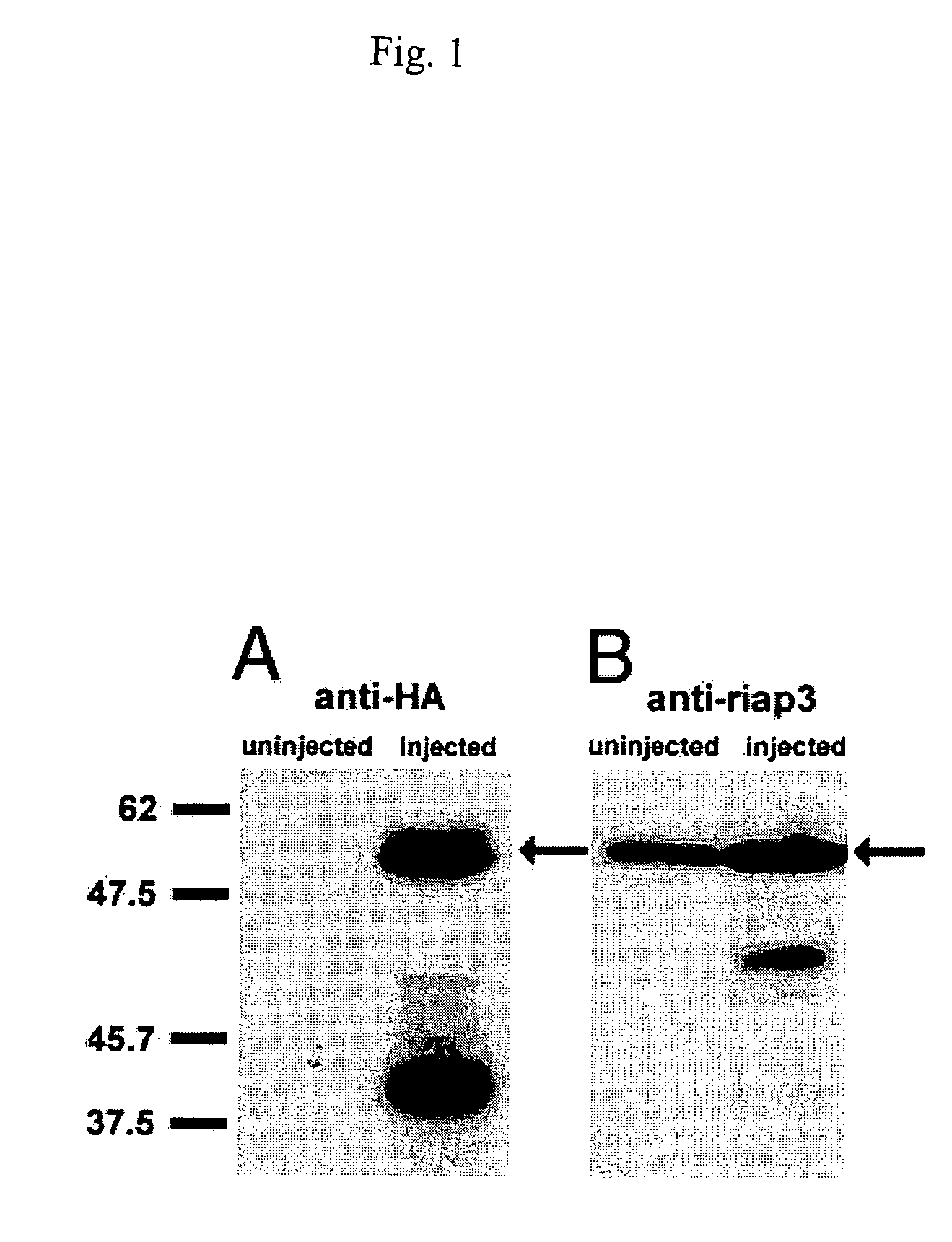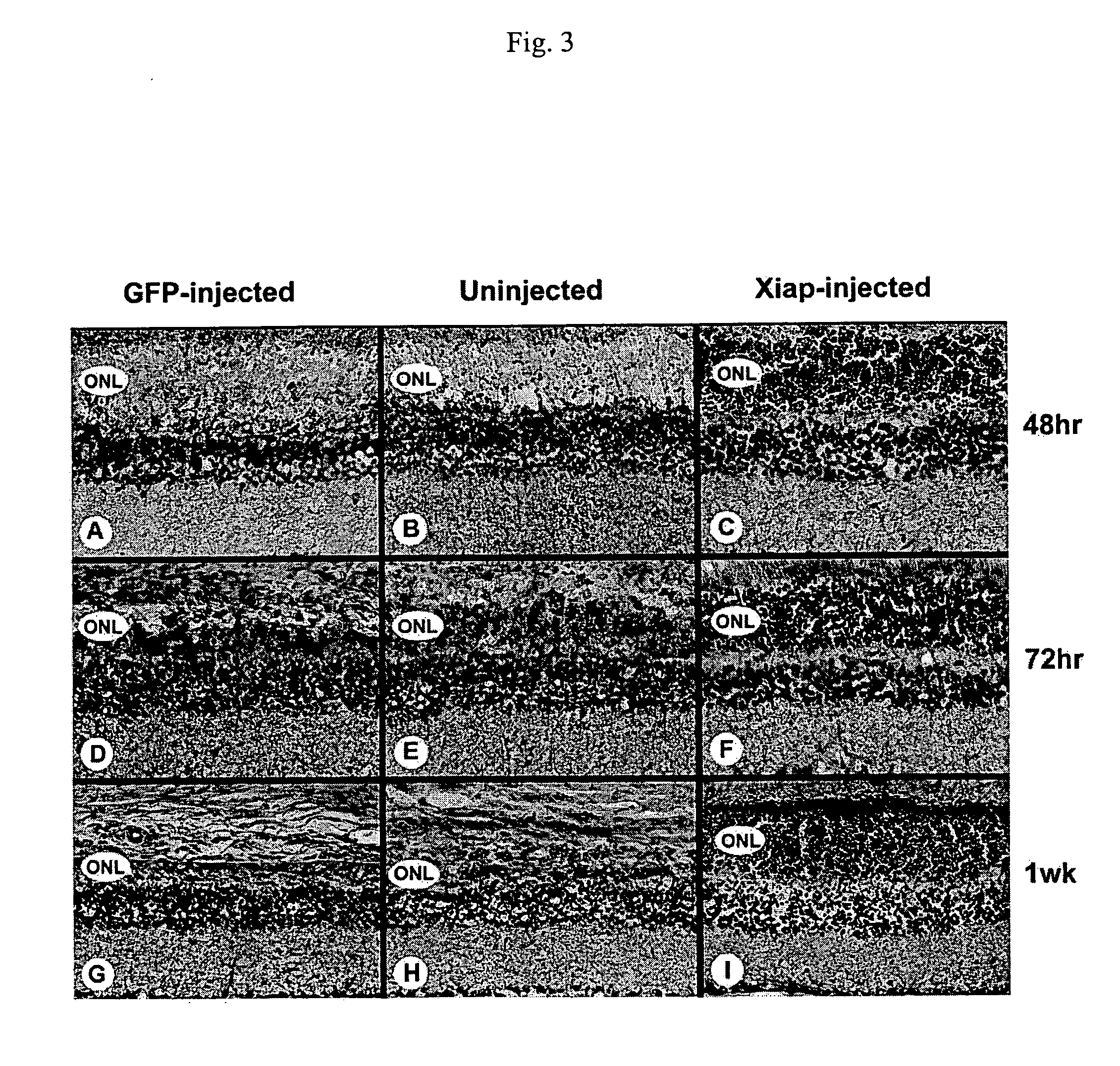XIAP therapy
a xiap therapy and ion channel technology, applied in the field of xiap therapy, can solve the problems of irreversible blindness worldwide, peripheral vision loss, and retinal degeneration, and achieve the effects of peripheral vision loss, night blindness, and peripheral vision loss
- Summary
- Abstract
- Description
- Claims
- Application Information
AI Technical Summary
Benefits of technology
Problems solved by technology
Method used
Image
Examples
example 1
XIAP Rescue in a Chemotoxic Model of Retinal Degeneration
[0080] We tested the protective effects of XIAP in a chemotoxic model of retinal degeneration. This model involves the intraperitoneal injection of N-methyl-N-nitrosourea (MNU) in rats, which results in massive photoreceptor cell apoptosis by 24 hours, as reflected by TUNEL staining in the outer nuclear layer. By 72 hours post-MNU injection, there is a complete destruction of the outer nuclear layer of the retina. We used serotype-2 AAV vectors to introduce XIAP into the rat eye. Serotype-2 AAV transgene expression begins at approximately two weeks post-delivery and appears to be optimal at 6 weeks post-delivery. We performed subretinal injections of AAV encoding XIAP or green fluorescent protein (GFP-control) driven by the mouse opsin promoter (MOPS). The right eye of the animal was given the virus and the left eye was used as a normal, uninjected control. Six weeks post-injection, we delivered an intraperitoneal injection o...
example 2
XIAP Rescue in a Rhodopsin Transgenic Rat, a Genetic Model of Retinitis Pigmentosa
[0084] The P23H transgenic rat has a mutation (histidine substituted for proline in position 23) in the rhodopsin gene. The same mutation is responsible for the most common form of autosomal dominant retinitis pigmentosa (ADRP) in North America. Twelve percent of all human ADRP cases are caused by this mutation, and thus, any therapeutic benefits by XIAP that are seen in this animal model could be directly applicable to the human disease.
[0085] There are several lines of P23H transgenics available, and these differ in the rates of retinal degeneration. For all of them, photoreceptor loss begins at approximately 2 weeks of age, but the speed of progression of the disease is quite variable in the different lines. Line 1 has a relatively rapid retinal degeneration such that by 3 months, only a few layers of photoreceptors remain (10-12 layers are present in the normal retina). The S334ter transgenic rat...
example 3
XIAP Protection of Different Layers of the Retina Against Retinal Ischemia
[0102] A number of studies have shown that cell death by apoptosis is a key event in retinal ischemia. Cell death occurs initially in the ganglion cell layer and this is followed by apoptosis of the cells in the inner and outer nuclear layers. The involvement of caspases has been well documented and inhibitors of caspases have been shown to be neuroprotective. Since XIAP is a potent inhibitor of caspases 3, 7 and 9 and has been shown to provide neuroprotection in a number of neurodegenerative models, including the 4-vessel occlusion model of neuronal ischemia, we predict that XIAP should have a similar neuroprotective effect in retinal ischemia.
[0103] Methods
[0104] AAVs encoding HA-tagged XIAP or GFP driven by the chicken beta actin (CBA) promoter were generated in the laboratory of Dr. William Hauswirth (University of Florida, Gainesville). Following anaesthesia and pupil dilation, 2 μl of CBA-XIAP or CBA-...
PUM
| Property | Measurement | Unit |
|---|---|---|
| Cell death | aaaaa | aaaaa |
Abstract
Description
Claims
Application Information
 Login to View More
Login to View More - R&D
- Intellectual Property
- Life Sciences
- Materials
- Tech Scout
- Unparalleled Data Quality
- Higher Quality Content
- 60% Fewer Hallucinations
Browse by: Latest US Patents, China's latest patents, Technical Efficacy Thesaurus, Application Domain, Technology Topic, Popular Technical Reports.
© 2025 PatSnap. All rights reserved.Legal|Privacy policy|Modern Slavery Act Transparency Statement|Sitemap|About US| Contact US: help@patsnap.com



